MXA RACE TEST: 2019 HONDA CRF250RX CROSS-COUNTRY
Q: FIRST AND FOREMOST, HOW DOES THE 2019 HONDA CRF250RX OFF-ROAD BIKE DIFFER FROM THE 2019 HONDA CRF250 MOTOCROSS BIKE?
A: In case you haven’t noticed, there is a new breed of off-road bike on the market today. In the past, the typical off-road bike was a purpose-built for enduro. Although it was often based on a couple-year-old motocross model, it didn’t share much in terms of intent with its motocross brethren. The old-school off-road model had a wide-ratio gearbox, six-speed transmission, headlight, big tank, handguards, digital speedo/odometer, spark arrestor and lower-line suspension components. Classic examples of this would be the KTM EXC-F, Husqvarna FE, Suzuki RMX and Yamaha WR models. While all of these purist offroad models are still on the showroom floors, they have been joined by competition off-road bikes like the Yamaha YZ250FX, Yamaha YZ450FX, Yamaha YZ250X two-stroke, Husqvarna FX350, FX450, TX300 two-stroke, KTM 250XC-F, 350XC-F, 450XC-F, 250XC two-stroke and 300XC two-stroke. These bikes are labeled as cross-country models, which is code for motocross models with minimal compromises made for off-road use.
This is where the 2019 Honda CRF250RX comes into the picture. For all intents and purposes, it is a 2019 Honda CRF250 motocross bike with a handful of off-road accoutrements added. More moto/less enduro equals a cross-country racer. The CRF250RX differs from the CRF250 in eight ways:
(1) Retail price is $8299 for the RX and $7999 for the CRF250.
(2) Fuel capacity is 2.2 gallons versus 1.6 gallons.
(3) It weighs 6 pounds more than the already-heavy 227-pound CRF250.
(4) Dunlop AT-81 tires are spec’ed over the CRF250’s Dunlop MX3S tires (along with an 18-inch rear wheel).
(5) The CRF250RX has a forged-aluminum side stand.
(6) An O-ring chain comes on the RX model.
(7) The fork and shock springs are one step lighter than the CRF250 components (along with lighter valving).
(8) The exclusive CFR-RX ECU mapping is designed to improve torque for off-road situations.

Q: WHAT HINDERS THE 2019 HONDA CRF250RX FROM BEING A MOTOCROSS BIKE?
A: There are always compromises when using a bespoke off-road bike as a motocross bike. How many compromises? Two to be exact.
(1) The vast majority of the 6 extra pounds is mounted high on the chassis in the form of the large fuel tank that Honda borrowed from the CRF450RX. Conservatively, one half of the extra 6 pounds is located up high behind the head tube in the form of gasoline. Additionally, the CRF250RX is 1 inch wider at the radiator wings than the CRF250. One inch may not sound like much, but every test rider mentioned it.
(2) The suspension is softer. We thought this would be a deal breaker for most motocross racers, but AMA Pros, sumo wrestlers and Supercross aficionados aside, the 49mm Showa coil-spring forks and shock were roundly applauded. Vets and Novices loved the suspension.

Q: CAN THE 2019 HONDA CRF250RX BE USED AS A MOTOCROSS BIKE?
A: You bet. How so? Underneath the big tank is the heart and soul of a 2019 Honda CRF250 motocross bike. It shares the brakes, frame, airbox, five-speed transmission, engine architecture, dimensions, frame geometry, triple clamps, handlebars, subframe, seat, fender, swingarm, shock linkage, wheelbase, 44mm throttle body, compression ratio, electric starter, titanium valves, battery, camshaft, three launch control systems and three push-button maps with its supposedly racier brother.
Q: WHAT ARE THE ADDED FEATURES ON THE 2019 HONDA CRF250RX?
A: The main focus of Honda’s R&D department was to build a cross-country version without spending too much money. The key ingredient of this recipe was to leave as much of the 2019 CRF250 motocross bike as possible intact and just add on the must-have off-road paraphernalia (big tank, 18-inch rear wheel, O-ring chain and side stand). Thus, there is no purpose-built six-speed gearbox, handguards, headlight, instrument panel or spark arrestor on the 2019 CRF250RX. It may be a bare-bones off-road bike, but it bristles with all the good stuff from the CRF250 motocross bike. That list includes:
(1) Launch control. Like the RX, the CRF250 gets the three-mode launch control. We can’t think of any use for this on a 250cc enduro bike, but it might help in mass-start cross-country races.
(2) Ignition maps. There are three push-button maps. The stock map is indicated by a single flashing blue light on the left-side map switch. The mellow map is engaged when the blue light flashes two times. The aggressive map is in effect when the blue light flashes three consecutive times.
(3) Fork guards. The 2019 CRFs, including the CRF250RX, got wraparound fork guards to improve rock-ding protection.
(4) Bars. Honda went from 7/8th Renthal bars to oversized 1-1/8th Renthal Fatbars on the CRF and CRF-RX.
(5) Brake caliper. The front brake caliper was redesigned for 2019 with a larger 30mm piston to work in unison with the previous dual, 27mm piston caliper. This mod improved brake modulation on the 270mm front rotor.
(6) Triple clamp. The top triple clamp now features two handlebar locations that result in four total riding positions. The two added positions enable the rider to move the bars across a 26mm range, including 10mm farther rearward from the stock position.
(7) Engine guard. The engine guard was redesigned to increase airflow for improved engine cooling while still offering decent case protection.
(8) Footpegs. The footpegs are 20 percent lighter and have a new shape to shed mud more easily; however, because the forged aluminum side stand needs something to bolt to, the left footpeg bracket was redesigned to do double duty, holding both the footpeg and side stand. If you have no need for the side stand, it can easily be removed, but the clunky oversized steel bracket remains hanging out in the air. You would need to buy a stock CRF250 footpeg bracket to clean up the look.

Q: HOW DOES THE 2019 CRF250RX ENGINE COMPARE TO THE 2019 CRF250 ENGINE ON THE DYNO?
A: The 2019 Honda CRF250 motocross bike produces 42.68 horsepower compared to the CRF250RX’s 42.40 horsepower. That is a very modest difference. Peak horsepower is only 300 rpm higher on the CRF250, and torque is 19.97 foot-pounds on the CRF250 and 19.80 on the CRF250RX. In short, the CRF250RX and CRF250 pump out the same numbers, same curve, and almost identical peak.
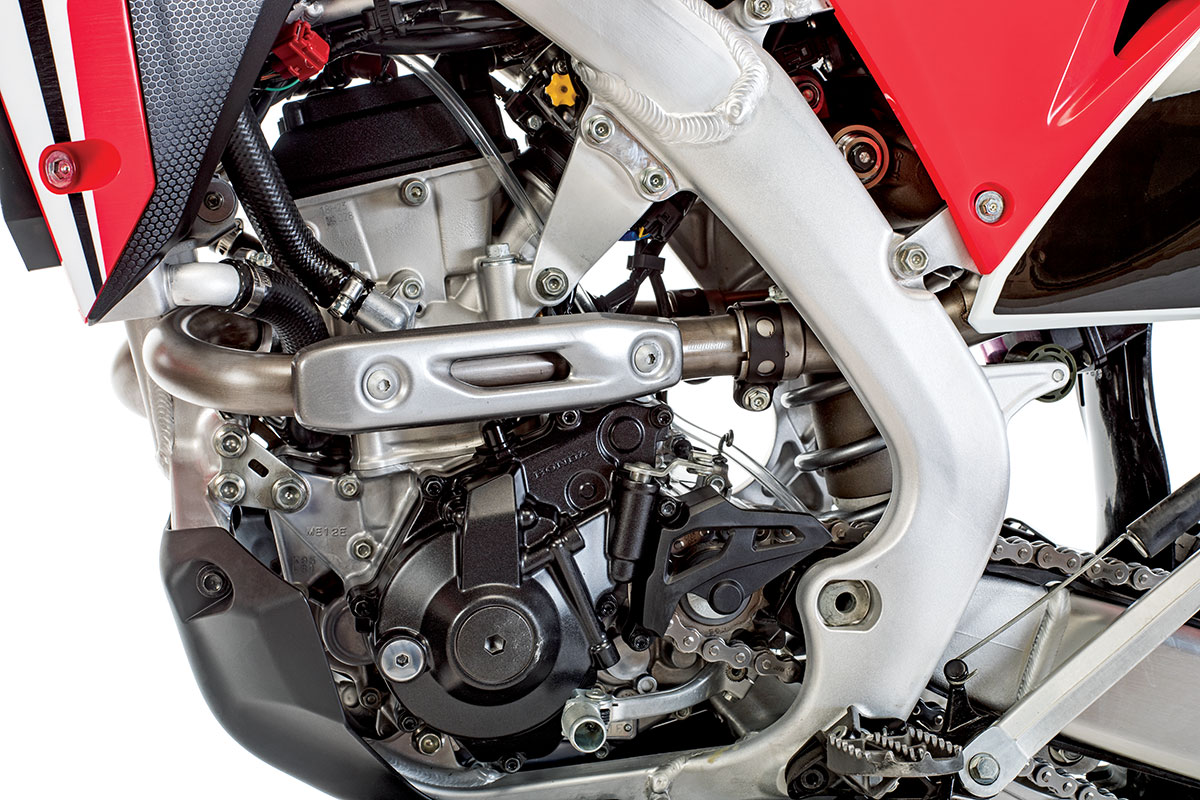
Q: HOW DOES THE 2019 CRF250RX ENGINE COMPARE TO THE 2019 CRF250 ON THE TRACK?
A: Right up front, we want every loyal Honda CRF250 owner to know that the 2019 CRF250 has a much better powerplant than the 2018 model. There is improved throttle response that gets to the meat of the powerband quicker and pulls harder on top. The power curve tracks the exact same linear curve as last year’s CRF250 but with more power across the board.
Given those statements, you would be hard pressed to understand what the MXA test riders could possibly complain about on the 2019 CRF250. But, complain they did. In motion, the 2019 Honda CRF250 motocross engine lacked snap down low. It was hard to get on the pipe coming out of corners. It was sluggish from low to mid. It didn’t jump out of a corner like a YZ250F, KX250, 250SXF or FC250. In fact, even the much-maligned Suzuki RM-Z250 would kill it when the speed and rpm dropped below quasar. Once you got it back on the pipe, it ran great, revved high and was more than competitive.
As for the 2019 CRF250RX, it had what every test rider wanted but didn’t get on the CRF250 motocross-tuned engine. Regardless of what the dyno numbers reveal, these two engines are nothing alike. The CRF250RX picked up clean off the bottom and had a torquey pull into the middle. It didn’t bog. It felt much stronger on the exit of turns and kept right on churning into the midrange.
Q: HOW CAN TWO IDENTICAL ENGINES RUN SO DIFFERENTLY?
A: That is what we wanted to know. The Honda CRF250 had a mid-and-up powerband, while the CRF250RX had a low-to-mid powerband, yet they are identical engines. The heads are the same. The cases are the same. The valves are the same. The camshaft is the same. The piston is the same. Everything is the same on the CRF250 and the CRF250RX. How two engines with absolutely identical mechanical parts could run so differently is a mystery. But, it is a mystery that was easy to solve. We checked the part numbers for the black boxes on both bikes; they were different. It turns out that the CRF250RX black box has different fuel quantities and ignition advance down low compared to the CRF250 motocross black box.
Q: WHAT DID THE MXA TEST RIDERS THINK OF THE TWO POWERBANDS?
A: The CRF250 motocross engine felt faster (when it was in the meat of its powerband). It revved quicker and carried over the top a little stronger, while the CRF250 offroad engine felt torquier, stronger down low and pulled in the midrange better. On a fast track with a Pro rider on board, the CRF250 engine was good, but if you put a Vet on it he complained about it being sluggish out of the corners. On a track with a lots of turns, both the Vet and National Pros felt that the CRF250RX engine was better, because it didn’t have to wait to get on the pipe before it would move. The two engines became matters of personal choice.

Q: WHAT DID WE HATE?
A: The hate list:
(1) Five-speed. The main competitors of the 2019 Honda CRF250RX come with either six-speed transmissions or wide-ratio five-speeds. The CRF250RX has the exact same five-speed gearbox as its motocross brethren. Obviously, that is not a deal breaker for motocross use, but for serious off-road use the CRF250 does not have the requisite ultra-low first gear and quasar-fast top gear.
(2) Weight. It is evident to the MXA wrecking crew that the 2019 CRF250RX off-road model is too heavy. It weighs 6 pounds more than the 2019 Honda CRF250. Adding to the CRF250RX equation is a pronounced deficit in the weight of the additional fuel.
(3) Launch control. MXA has never felt compelled to use launch control on a 250 four-stroke, but if we did, we would want a device that was a lot easier to activate.
(4) Engine covers. The paint on the ignition and clutch covers were scratched on the first ride. Honda should switch to brushed aluminum so the covers will look better longer.
(5) Maps. There were three different maps to choose from—although every test rider preferred the stock map (one flashing blue light). The stock map produced the most power at every point on the curve over the mellow map (two flashing blue lights) or aggressive map (three flashing blue lights).
Q: WHAT DID WE LIKE?
A: The like list:
(1) Handling. This is an easy bike to get comfortable on.
(2) Forks. The Showa coil spring forks work great for a wide range of riders. Yes, they are softer than the CRF250 motocross forks, but this is a plus, not a minus, for anyone who is light, slow or disgruntled by the standard setup of motocross forks.
(3) Tires. Dunlop AT-81 off-road tires have increased durability and performance on a wider range of terrain than the intermediate-terrain Dunlop MX3S tires that come standard on the motocross model.
(4) Rear fender. When you grab the rear fender to pick up the CRF250RX, you will appreciate the rounded shape that Honda molded to the lower lip of the plastic. Very comfy.
(5) Clutch. It offers a decent clutch package and has an easy pull at the lever. But, we run stiffer clutch springs on our CRF250, so we were less than enamored by the 10-percent-softer clutch springs on the identical clutch in the CRF-X.
(6) Adjustable bar mounts. The top triple clamp features two handlebar-holder locations that allow the handlebars to be moved across a 26mm range (and when the mounts are rotated 180 degrees, it allows an additional 10mm of adjustment).
(7) Front brake. All four Japanese brands rushed to keep up with KTM’s Brembo brakes by putting oversize 270mm rotors on their bikes. The problem with this strategy is that when mixed with their old-school calipers, the big rotors lacked modulation and were grabby. For 2019, Honda was the first Japanese brand to fix this issue by redesigning its front caliper with two different size pistons. The bigger 30mm piston provided better modulation, while the smaller 27mm piston kicked in the pucker power. They still aren’t Brembo strong, but these brakes are a big improvement over the previous stop-gap solution.
Q: WHAT DO WE REALLY THINK?
A: Maybe it’s just us, but we don’t fully understand what Honda is trying to accomplish. Yeah, yeah, yeah, we know that Honda wanted the CRF250RX to be considered an off-road bike, but it is really just a Honda CRF250 motocross bike with a different map, big tank, 18-inch rear wheel and softer suspension. Yes, the suspension is softer and the mapping is repurposed further down the powerband, but these are fairly normal hop-up mods. It is an “almost” bike—almost a motocross bike and almost a cross-country bike.
If you are looking for an all-around 250cc four-stroke to ride in the desert this weekend and at Glen Helen next weekend, both the CRF250 and CRF250RX are more than capable. The decision comes down to which aspect of the sport is more important to you. If you plan to use it more for motocross, go with the CRF250; if more for offroad, go with the CRF250RX.
MXA’S 2019 HONDA CRF250RX SETUP SPECS
This is how we set up our 2019 Honda CRF250RX for racing. We offer it as a guide to help you find your own sweet spot.
SHOWA COIL SPRING FORKS
For riders looking for plusher suspension than what a showroom stock motocross offers but firmer than the typical off-road bike offers, Honda hit the nail on the head with the 2019 CRF250RX setup. Initial settings were close to spot-on. With stock settings, the forks rode down in the stroke. We added a few clicks of compression to allow them to ride higher. Some of the riders also dropped the forks in the clamps 2mm to lessen chassis oversteer. If you are experiencing oversteer, drop the sag a couple of millimeters before lowering the forks. For hardcore racing, these are MXA’s recommended 2019 CRF250RX fork settings (stock settings are in parentheses):
Spring rate: 4.5 N/m
Compression: 7 clicks out (9 clicks out)
Rebound: 13 clicks out (14 clicks out)
Fork-leg height: 3mm (5mm)
Notes: The forks worked well for 140- to 200-pound riders. Ride with these forks before you send them to your suspension guru. You might be surprised how well they work for your weight and skill level.
SHOWA SHOCK SETTINGS
We dropped the race sag to 107mm to lower the overall bike height and stiffened up the low-speed compression to make it ride higher in its stroke. For hard-core racing, these are MXA’s recommended 2019 CRF250RX shock settings (stock settings are in parentheses):
Spring rate: 51 N/m
Race sag: 107mm (105mm)
Hi-compression: 3-1/4 turns out (3-1/2 turns out)
Lo-compression: 9 clicks out (11 clicks out)
Rebound: 7 clicks out (8 clicks out)
Notes: The shock is consistent. It doesn’t do anything out of the ordinary. Lighter riders under 140 pounds will want to stick with the stock setting. ο


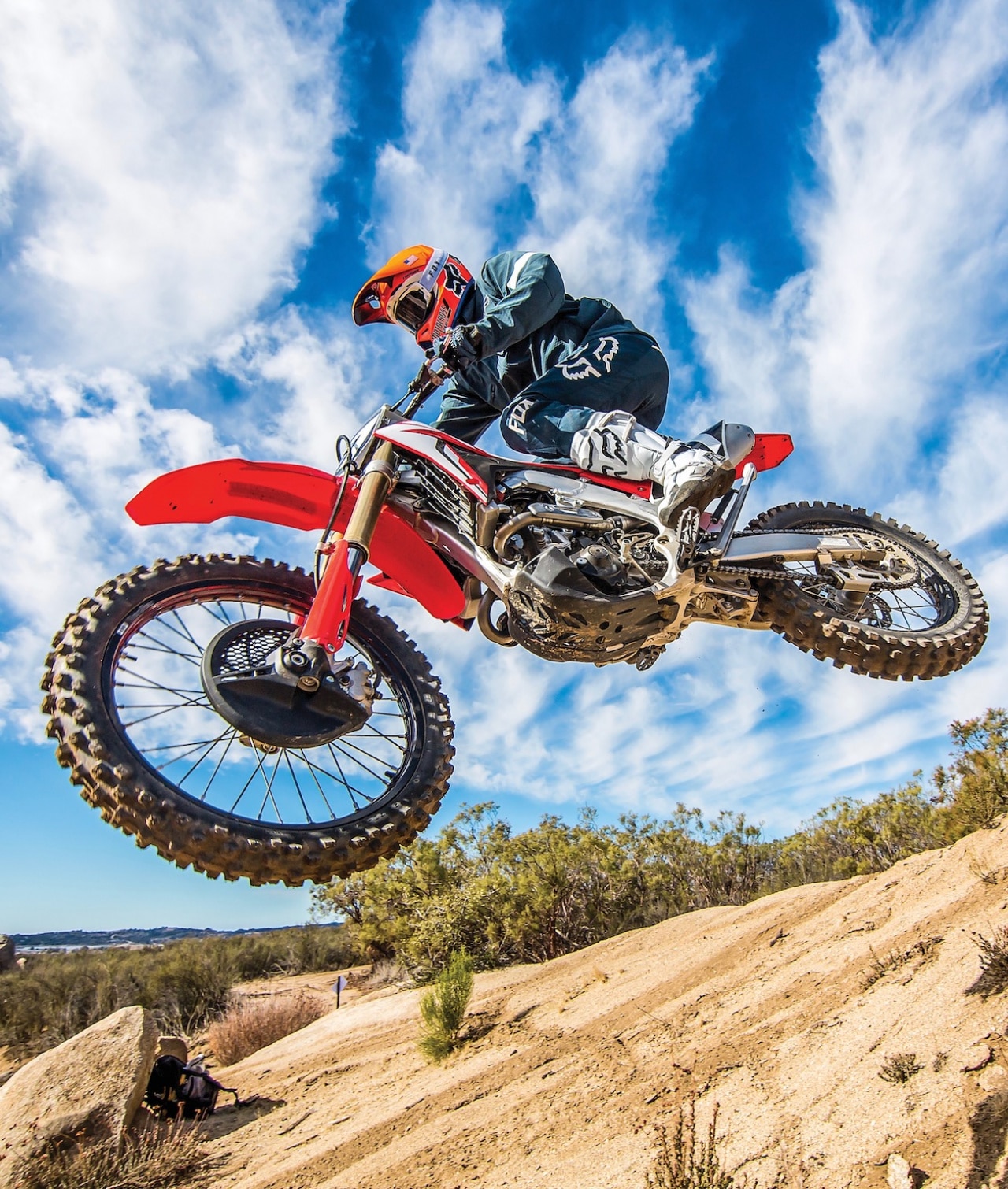
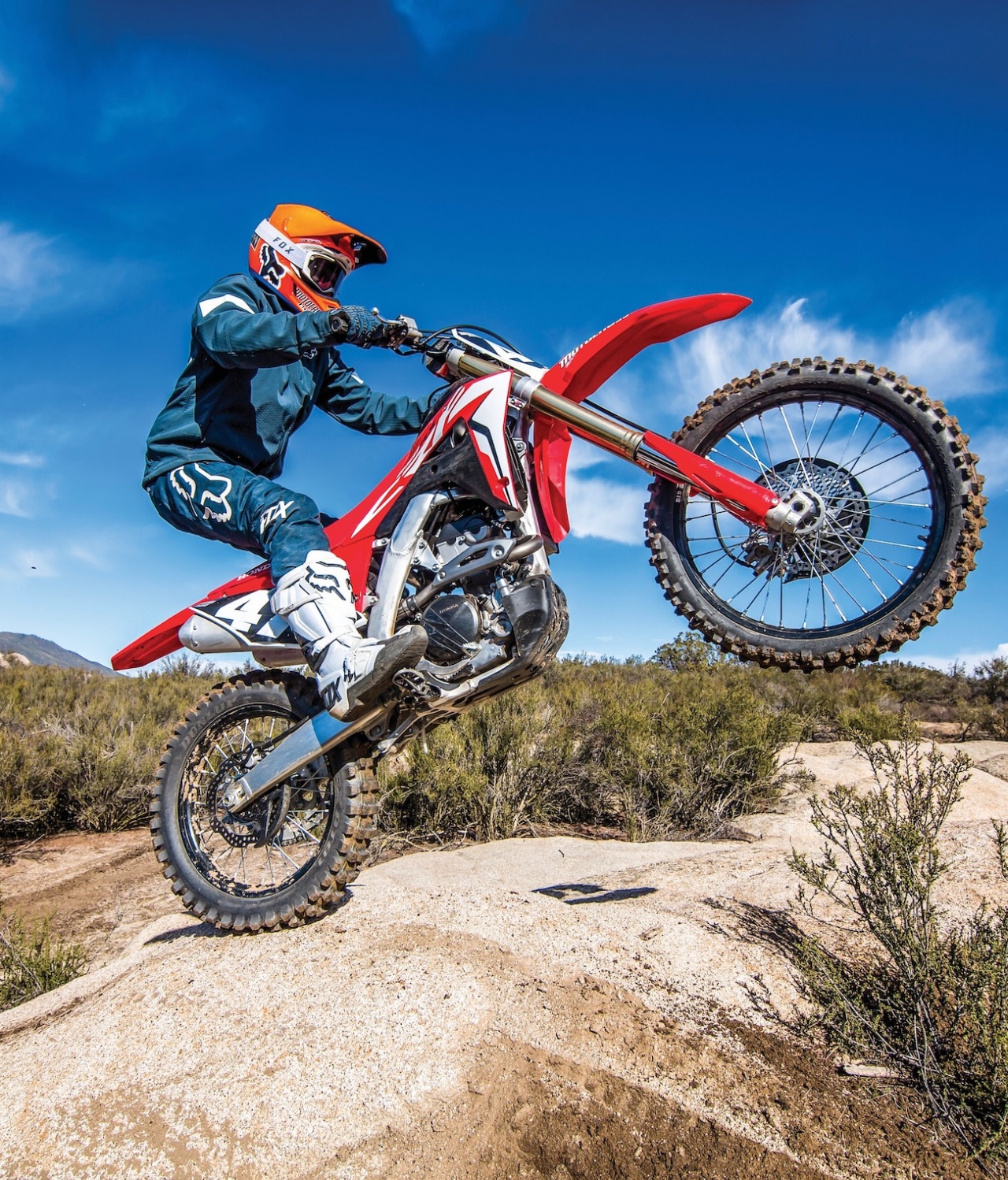
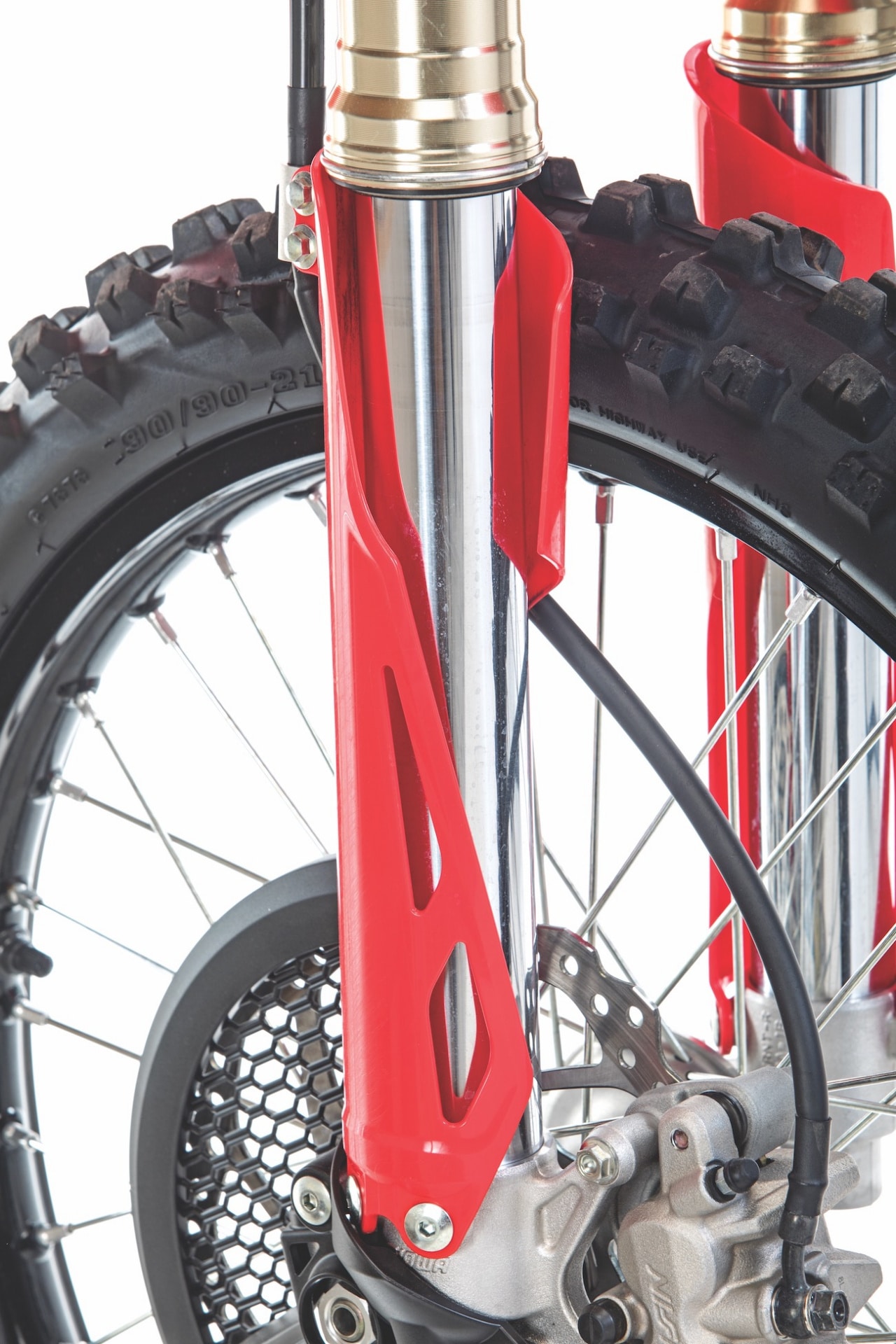

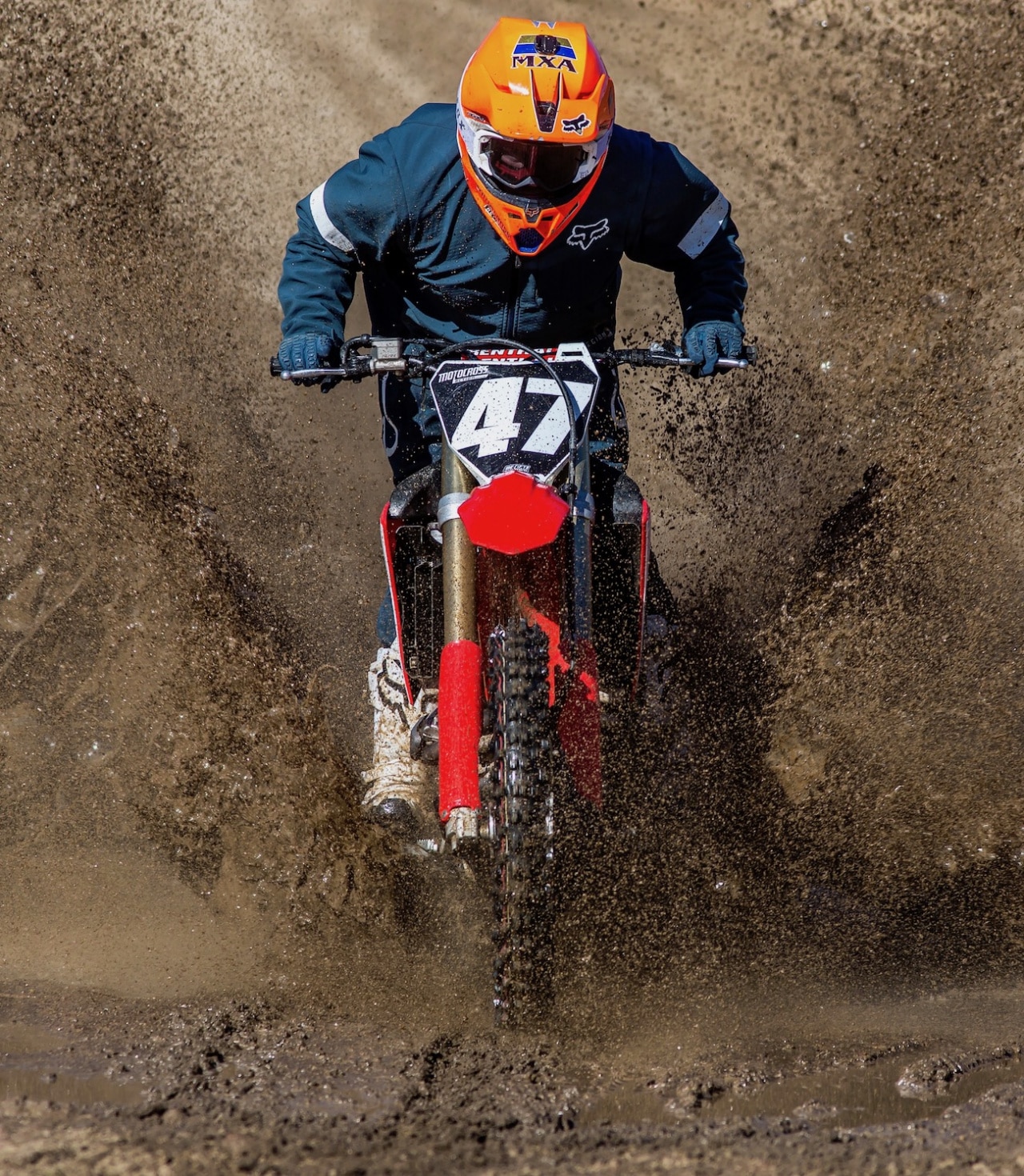

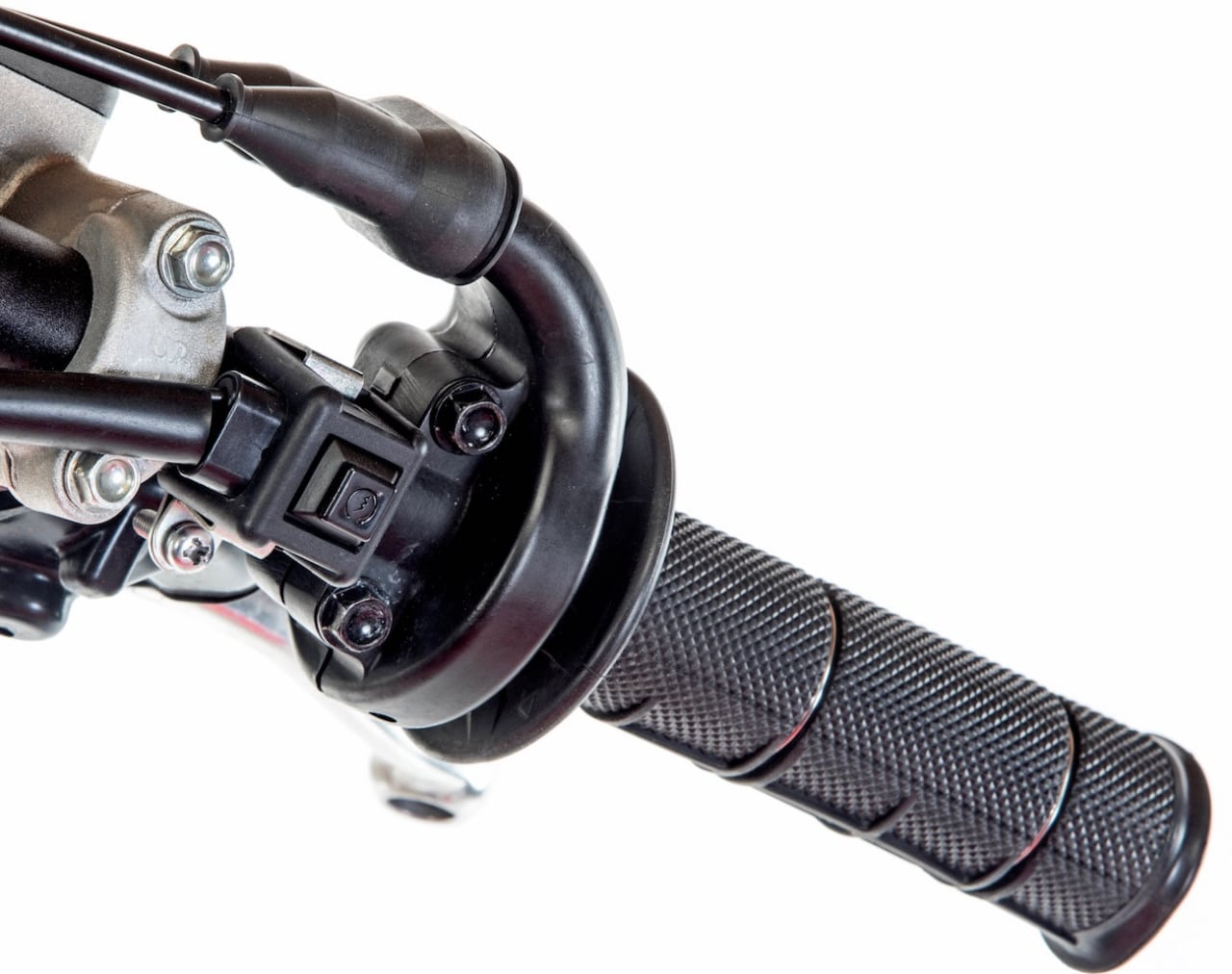
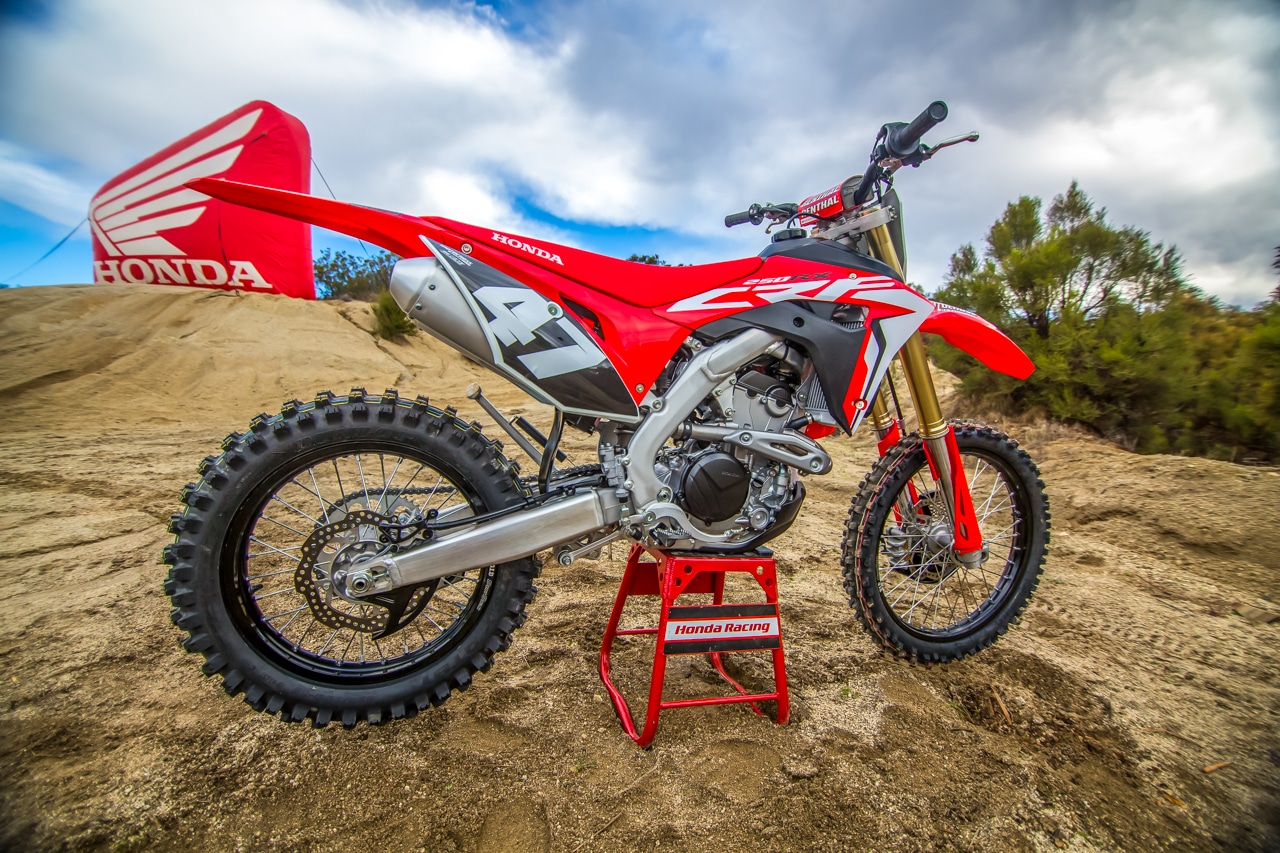
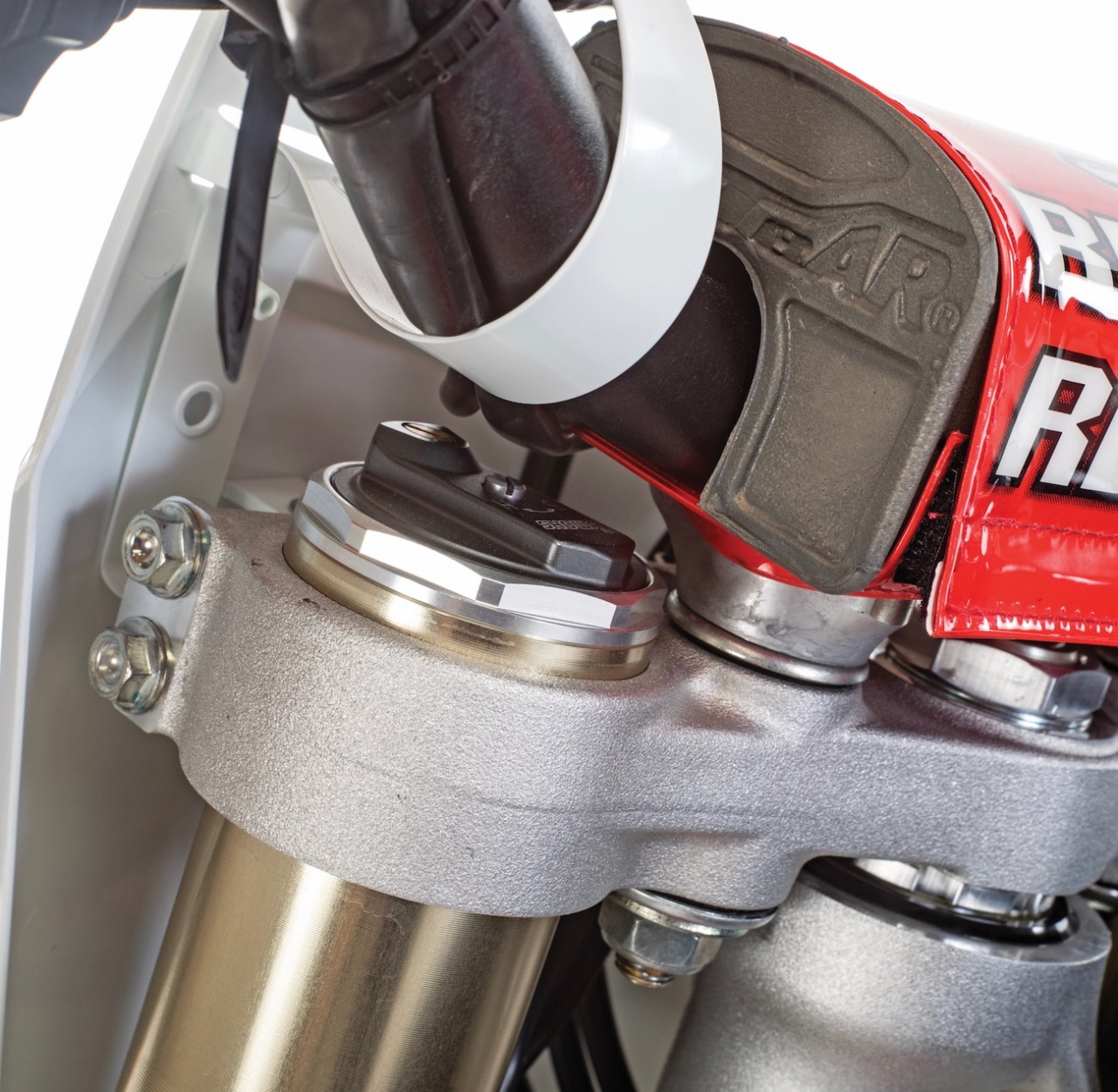



Comments are closed.